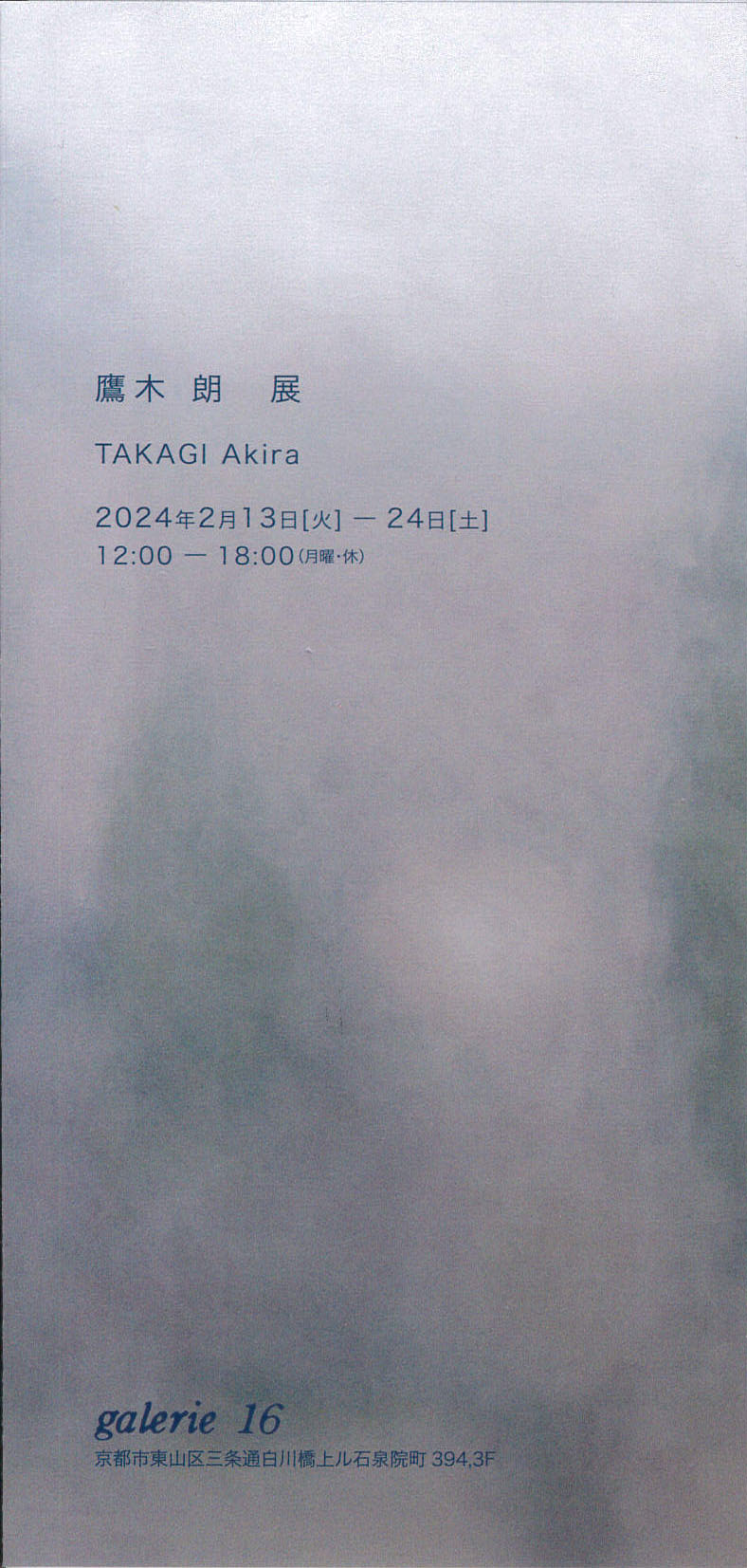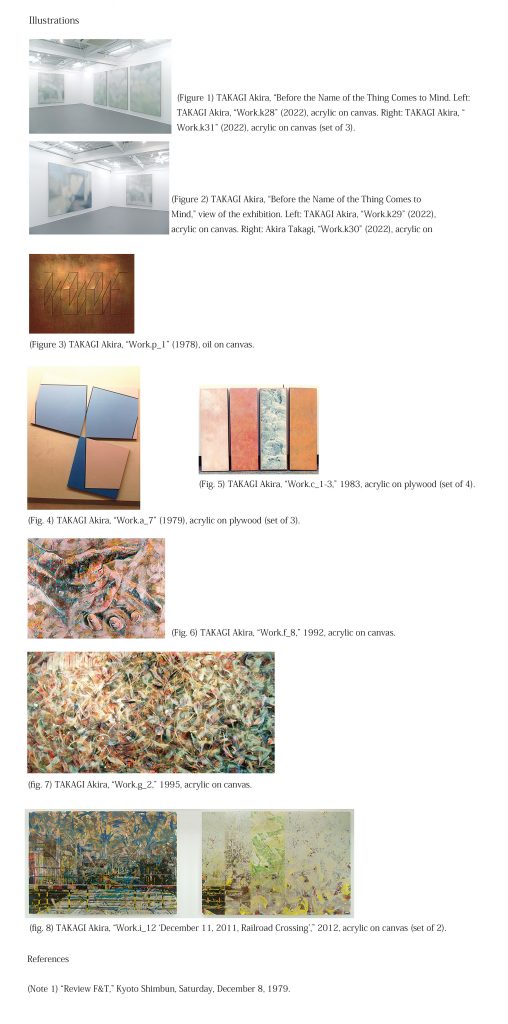
Feb. 13th tue– Feb. 24th Sat, 2024
12:00~18:00 (Monday closed)
One day I saw a grove of trees in the distance.
It looked, from here, like a pale gray wall.
If you look closely, you can see that there are individual trees there, probably with countless branches and leaves.
On the canvas, many lines overlap each other in various colors.
Gradually, the overlaps are drawn flat like a wall.And they seem to be moving away from me into the infinite beyond
TAKAGI Akira

How does he know the scenery I saw?
-An attempt by TAKAGI Akira to capture the viewer’s memory of the work in a painting
Introduction
TAKAGI Akira (born in 1957) is a painter who has been active mainly in the Kansai region since around 1980. Starting with his first solo exhibition while a student at Kyoto City University of Arts (Gallery KAN, Kyoto, 1979.12.4-9), he has participated in group exhibitions starting with the Yoshihara Jiro Prize Art Competition (Osaka Contemporary Art Center, 1981.3.16-1981.4.4), and has exhibited almost annually at established contemporary art galleries and, he has shown his new works nearly every year in solo exhibitions at galerie 16 (Kyoto, Japan), a long-established contemporary art gallery, and other venues. In this paper, we would like to review Takagi’s work from the beginning of his career to recent years, and offer some thoughts on his work.
1. How does he know the landscape I saw?
In the winter of 2022, Takagi held a solo exhibition titled “Before the Name of the Thing Comes to Mind” (galerie 16, November 29-December 10, 2022). Upon entering the exhibition space, visitors catch eyes by the large paintings hanging on the white walls (Figures 1 and 2). It was a canvas measuring 194 cm (H) x 130.3-259 cm (W).
Ambiguous image painted in acrylic paint on the large canvas that enveloped the viewer. Because the outlines of the motifs have been wiped away, the viewer’s vision has blurred in the same way it is when raindrops enter the eye, and it is not possible to instantly discern what is being painted.
However, after looking at it for a while, you realize that trees, grass, and houses with white exterior walls are painted. Then, familiar street scenes begin to appear in your mind’s eye. For example, leaves rustling in the wind, cars whizzing past passers-by…. Memories of the streets that we have all experienced at one time or another take shape, take on color, and are spun out onto the canvas.
Standing in front of such works by Takagi, we may think: Why did this artist do what I saw? How does the artist know the landscape I saw?
Then viewer realizes the artist is depicting what the viewer saw, in other words, the artist is depicting the viewer’s memory of what the one has seen.
2. Viewing information from the outside world – paintings – through the body
We may remember M.C. Escher’s (1898-1972) ‘Belvedere’ (1958) and ‘Waterfall (1961), in which he incorporated optical illusions into his paintings, and how we lost track of the positioning of the columns and the flow of water. ‘Work.p_1’ (Fig. 3)is an oil painting of Takagi’s earliest artwork in 1978. The position of the long and short lines and the complicated color combination create a mysterious world in which it is uncertain whether the painted straight lines are in the foreground or the background. We cannot equate this work with trompe l’oeil. It makes use of the optical illusions of the viewer, it is forced to watch the work while checking the relationship between the lines. There, we are no longer the single-minded viewers who accept the world’s perspective from a third party. We are looking closely at the paintings, in brief, the outside world, checking the position and length of each line and wondering what is being depicted.
The following year, in 1979, Takagi held his first solo exhibition at Gallery KAN, Kyoto. Here, Takagi presented a unique work. ‘Work.a_7’ (Fig. 4) and other works of series.
A square is one of the shapes we remember as a rectangle with four equal sides and right angles. By arranging the supports, which depict combinations of straight lines that remind us of the square shape, next to each other or slightly apart, the square appears to slide to the left or the right. A reviewer of the exhibition at the time noted, “The squares look as if they were made by shifting two cards together in a fan shape or diagonally” (Note 1).
What is interesting about this series of works is (1) the selection of motifs that are familiar to us and (2) the fact that not all of the outlines of the motifs depicted. If a familiar motif, such as a square, is depicted as a motif, we can rely on our memory to fill in the missing parts of the motif and capture the sliding of the square. The comment in the exhibition review at the time about this series of works, “In the Kumi-works, a certain rhythm and the space occupied by it are foreseen” (Note 2), means that we feel the missing parts of the squares that are not drawn on the supports or the blank space on the wall.
3. Freeing us from being bound by a collection of meanings
As we have seen, the fact that Takagi dares not to depict all the outlines of the motifs in his works. This is evident in his early works and is visible in his later works. As strokes of varying lengths and thicknesses began to appear (Fig. 5), motifs such as body parts (Fig. 6), plants and trees (Fig. 7), and artificial objects (Fig. 8) began to appear. The outlines of all motifs are partially wiped away by strokes, and now, as in the works mentioned at the beginning of this section (Figures 1 and 2), the motifs and strokes are almost the same. Since the artist did not draw clear outlines in his works, we are left to fill in the missing parts of the motifs from our memories. It is as if the artist handed over the paintbrush to us, and we continue to paint the rest of the picture. If you look at it like this, Takagi’s artistic activities can be seen as a transformation of painting from representing the artist’s image and view of the world to representing the viewer’s image and view of the world.
In the past, with the invention and development of photographic technology, artists released from painting motifs realistically. On the other hand, artists are now required to present images from their minds and their way of seeing the world in a more original way than anyone else, which the viewers of their works may not expect. On top of this, the current proliferation of image-generating AI is forcing the flesh-and-blood artist to ask what one should draw. Image-generating AI continues to convey images to us from a collection of meanings. There is little room for the body to be involved. Essentially, for example, what kind of thing is a leaf should differ minutely from person to person. Each of us should be able to sense how much of a leaf is a leaf and how much is not a leaf. To depict the world obtained through our physical senses, we need to have a state of memory before the names of things take root in our minds, and we can think of the depictions as being made just before memory takes on color and form.
Conclusion
So far, we have looked at Takagi’s artistic activities. As a result, one of the characteristics of his work is that he partially leaves the sovereignty of painting to us and that his work represents our way of looking at the world. The idea behind this was to liberate us from our fixed relationship with the world without the intervention of our physical senses. We have shifted from being given the meaning of “this is ____” to being able to feel “this is ____” from within ourselves through Takagi’s paintings.
In light of the above, Takagi’s artistic activities are not limited to physical products such as paintings but aim to encourage us to become more aware of how we see and feel the world through our physical senses.
HIOKI Yoko(Chief Curator, Kagawa Prefectural Museum)

